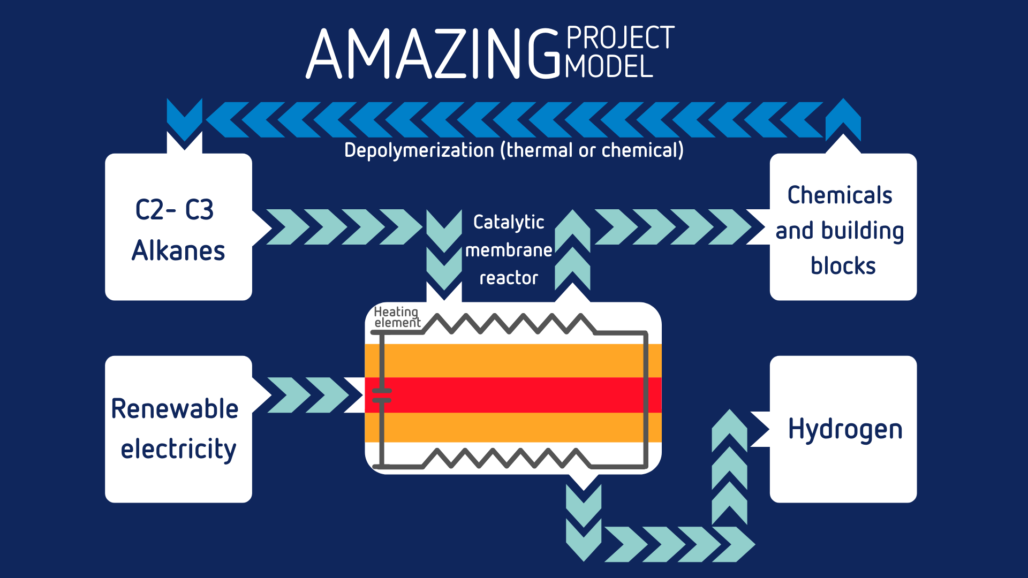Amazing is about replacing large-scale high-temperature cracking processes with electrically driven thermocatalytic dehydrogenation of alkanes to alkenes.
In short:
- There is an ever-increasing global demand for energy and materials
- Amazing is a German-Dutch project that aims at producing building blocks for plastics manufacturing more sustainable
- Large-scale high-temperature cracking processes will be replaced by using renewable electricity
- The Amazing project will deliver a unique family of self-supported catalytic ceramic membranes
Achieving CO2 emissions targets through Innovative Green Chemistry
Satisfying the ever-increasing global demand for energy and materials, while achieving the ambitious CO2 emissions targets of the EU for 2030 on climate change, requires the utilization of renewable resources (e.g. wind, solar) in the fuels and chemical industries.
The German-Dutch Amazing project has set itself the task of making the cracking processes employed to produce building blocks for plastics manufacturing more sustainable. By replacing large-scale high-temperature cracking processes (e.g., steam cracking of naphtha and/or ethane) driven by fossil-based fuels with renewable electricity to conduct thermocatalytic dehydrogenation of alkanes to chemical building blocks (alkenes), the CO2 emissions associated with energy-intensive cracking reactions can be reduced significantly.

Dehydrogenation of alkanes to alkenes
To achieve the project goals, the Amazing project team will design and fabricate proton conducting ceramic membranes and catalytic coatings for the dehydrogenation of alkanes to alkenes. The resulting membranes will be employed to perform hydrogen (proton) transport and thermal stability studies to understand the interplay between the membrane topology structure and chemical composition with the proton transport mechanisms, thermo-mechanical stability and possible interaction between the catalyst and the ceramic proton conducting membrane. The most promising membranes and catalyst coatings will be selected for an exploratory study on 3D manufacturing of the self-supported membranes.
By leveraging computation modeling of the 3D-printing process and the thermo-mechanical properties of the ceramic membrane it will be possible to identify possible mechanisms of failure during fabrication and operation. The feedback from this analysis will be critical to optimize the design and composition of the membranes. The performance of the membranes will be evaluated for the conversion of light alkanes to alkenes on a bimetallic catalyst supported on the ceramic membrane to create an integrated ceramic membrane reactor.
Utilization of catalytic membrane reactors
Finally, Amazing will explore the fabrication of a new type of membrane that is capable of conducting only protons in which the proton transport is driven by an electrical field. These membranes will be tested for the separation of hydrogen from the reaction mixture. The results from these activities will lay down the foundations for the utilization of catalytic membrane reactors, proton conducting membranes and 3D printing technology to create multi-material micro-/ macro-structured membrane systems for the production of chemicals using renewable electricity.
From alkanes to alkenes with electrical heating
The Amazing project will deliver a unique family of self-supported catalytic ceramic membranes and the technical feasibility of using 3D printing technology for the manufacturing of ceramic membranes with well-controlled chemistry and topology. This will allow the development of a membrane-stack reactor for the conversion of alkanes to alkenes using electrical heating. Furthermore, this project will provide the first examples of 3D printed proton conducting membranes for electrically driven hydrogen separation.
Stay in the know
Keep an eye out on our LinkedIn or newsletter for interesting updates on the Amazing-project.
You might also be interested in
Acknowledgement & partners
This project is co-funded with subsidy from the Topsector Energy by the Ministry of Economic Affairs and Climate Policy.









